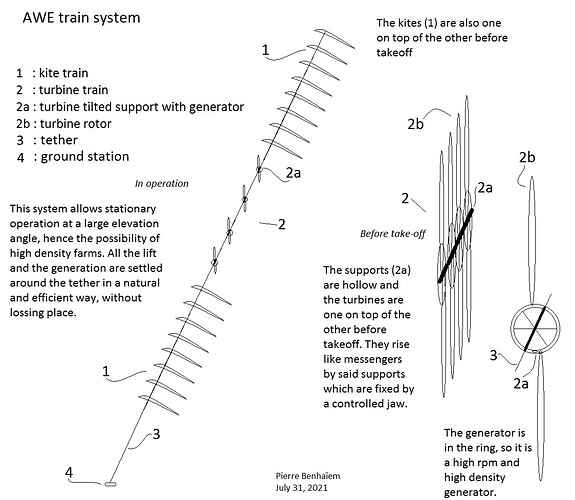I just compared tilted and not tilted turbines of equivalent power, under a lifting kite.
When the elevation angle is relatively low (30°- 40°) a far smaller lifting kite is required for tilted turbines.
But when the elevation angle is high (55°- 60°) both tilted and not tilted turbines require a lifting kite of same area.
And a high elevation angle can be more suitable to both safety and density. So under these conditions there is no drawback to using a not tilted turbine.
Yes, but the tether length is unacceptably long if we want to capitalize on high altitude operation
Hi Pierre,
Not sure on the “To tilt or not to tilt” / lifter kite “Yea or Nay” discussion - but just in case somebody wants to tilt a rotor this might be a nice way to do it
Enjoy 
/cb
1 Like
I agree @gordon_sp, until the other side is examined.
Let us see the other side, so with not tilted turbines. I put a sketch of a AWE train system comprising kite trains and turbine trains. If we want about 1 MW at 10 m/s wind speed, 70 turbines of 10 m diameter each (78.5 m²) could be installed on the single tether. If less turbines are installed they would more undergo weight penalty. Say a turbine is 20 kg (to be optimist), comprising the generator at high rpm and density: 1.4 ton of turbines. The lifting kites have to lift such a weight (in addition to their own weight) even with low winds where the elevation angle will be far lower.
Kiwee seems to fly at about 60 degrees with an about 1 m² not tilted turbine and 4 m² lifting kite, producing 0.2 kW at 10 m/s wind speed, and 200-300 N thrust. Wind turbine Drag is about 70 newton: from this and from another document I have in paper format, the drag coefficient of a not tilted wind turbine could be something like 1.1.
To reach similar features at 1 MW scale, about 16 000 m² of lifting kites should be implemented, so 64 kites of 250 m² each. In yo-yo mode, by using only the kites, a similar value of 1 MW could be achieved without using crosswind motion, and about 10 MW with crosswind (soft) kites.
In addition stability and control are big concerns for stacked soft lifter kites in trains, rigid kites being more controllable and easier to implement in train, but heavier.
Hi @someAWE_cb , if tilted rotors generate large power in good conditions, even at 30-40° elevation angle, they could be relatively advantageous. At this stage, it is very difficult to answer yes or no given the multiplicity of factors. I just found it interesting that a not tilted turbine would not require more lifting kite area at a high elevation angle.
AWE Kite Train
The Kite Train system is an interesting concept. Perhaps we should start a new topic. I have many comments and suggestions.
My biggest problem with the system is the fact that the turbines are free to rotate about the axis of the tether. We must install vanes or paddles on each turbine to ensure that they orient to face the wind. Should we alternate rotation direction of the turbines to neutralize transverse torque? Unfortunately the paddles may interfere with the nesting of the turbines on the ground.
Autonomous launch and land is a problem. If we somehow manage to lift the first set of kites to launching height will they naturally separate? During launch, the turbines and second set of kites will be dragged across the ground. We must place them on rolling wagons to prevent this. How do we relocate the wagons when landing the system especially when there are wind changes?
An alternative idea is to use the Kitewinder system with a cable drive. The weight of the generators and conductive cable is eliminated and the problem of low inefficient generator speeds eliminated by different size pulleys on the cable drive system. A cable drive system with lighter tether can be operated at higher altitudes with a significant increase in power output.

